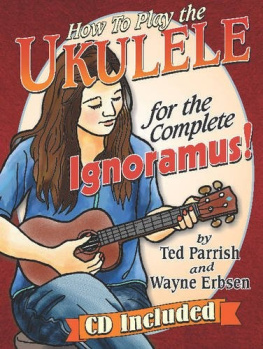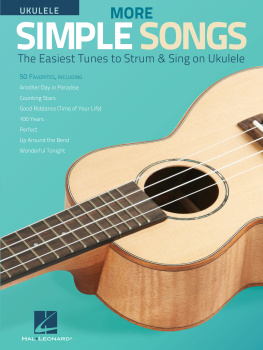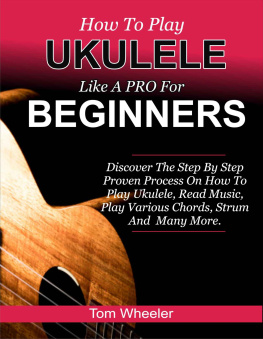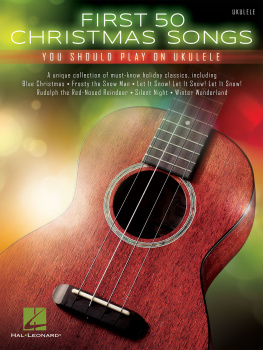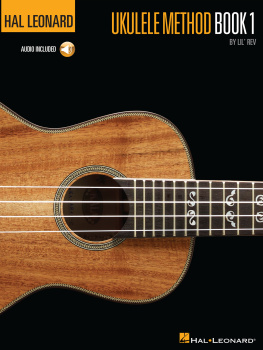Ted Parrish - How to Play the Ukulele for the Complete Ignoramus
Here you can read online Ted Parrish - How to Play the Ukulele for the Complete Ignoramus full text of the book (entire story) in english for free. Download pdf and epub, get meaning, cover and reviews about this ebook. year: 2015, publisher: Native Ground Books & Music, genre: Children. Description of the work, (preface) as well as reviews are available. Best literature library LitArk.com created for fans of good reading and offers a wide selection of genres:
Romance novel
Science fiction
Adventure
Detective
Science
History
Home and family
Prose
Art
Politics
Computer
Non-fiction
Religion
Business
Children
Humor
Choose a favorite category and find really read worthwhile books. Enjoy immersion in the world of imagination, feel the emotions of the characters or learn something new for yourself, make an fascinating discovery.
- Book:How to Play the Ukulele for the Complete Ignoramus
- Author:
- Publisher:Native Ground Books & Music
- Genre:
- Year:2015
- Rating:3 / 5
- Favourites:Add to favourites
- Your mark:
- 60
- 1
- 2
- 3
- 4
- 5
How to Play the Ukulele for the Complete Ignoramus: summary, description and annotation
We offer to read an annotation, description, summary or preface (depends on what the author of the book "How to Play the Ukulele for the Complete Ignoramus" wrote himself). If you haven't found the necessary information about the book — write in the comments, we will try to find it.
Ted Parrish: author's other books
Who wrote How to Play the Ukulele for the Complete Ignoramus? Find out the surname, the name of the author of the book and a list of all author's works by series.
How to Play the Ukulele for the Complete Ignoramus — read online for free the complete book (whole text) full work
Below is the text of the book, divided by pages. System saving the place of the last page read, allows you to conveniently read the book "How to Play the Ukulele for the Complete Ignoramus" online for free, without having to search again every time where you left off. Put a bookmark, and you can go to the page where you finished reading at any time.
Font size:
Interval:
Bookmark:

Table of Contents
Instructional MP3s
To help you learn the tunes in this book, visit www.nativeground.com/ukulele-ignoramus-mp3s to download the instructional MP3s that accompany this book, and enter the password uketime.

5, 6
Throughout the book youll find illustrations of an old gramophone with numbers below it. These numbers correspond to the MP3 tracks. You will find examples of all of the songs, including the chords and melody. We have also posted ukulele instructional videos on our website www.nativeground.com.
Throughout the book youll find audio track numbers in
ackets. They look like this: [AUDIO TRACKS 5, 6]. These numbers correspond to the MP3 tracks. You will find examples of all of the songs, including the chords and melody. We have also posted ukulele instructional videos on our website www.nativeground.com.
Welcome to the Ukulele!
W hether you call it a ukulele or a uke, it is one of the easiest instruments to play, even for a complete ignoramus. Trust us. Compared to other instruments, learning the ukulele will be a snap. Even if you have never played a musical instrument before, we guarantee that you will learn to play songs on the ukulele by using this easy book. All it takes is desire, dedication, and practice.

This book is aimed at the total and absolute beginner. Like the other books in the Complete Ignoramus series, well teach you the basic techniques for playing the instrument using simple folk songs that you know like the back of your hand. After you get the basics down, you can apply your new skills to practically any style of music. Pick up your uke at least once a day and youll be a bona fide ukulele player in no time.
Heres a little story: Ted and his wife Catherine gave his mom a ukulele for her 75th birthday. She had never played an instrument before in her life. They werent sure she would even want it. To their delight, she was excited and started to learn. Ted showed her two chords and she was off and running. Within two weeks, she was playing and singing a variety of songs. A year later she founded a ukulele club that now has over 185 members. The group is still going strong and Marlene continues to nurture new members who join the group.
The ukulele has taken the country by storm, and chances are good that there is a ukulele club or group right in your hometown. These clubs are great for learning and support, as well as making new friends. Once you start playing the ukulele you will surely find other like-minded folks out there. Dont forget about the internet. There are many videos on the web, including ones that support this book. So grab a ukulele and jump in with both feet, the waters fine. You WILL play the ukulele!
The first part of this book will help you understand how to hold, tune, strum, and play your ukulele. If you want to skip ahead to one of your favorite songs right away, go ahead. The songs are arranged by key and are roughly in order of difficulty, so try one of the early songs first. If you really want to work on some skills before you play songs, try the chord study on pages .
A Brief History of the Uke
I n the 1880s, Portuguese immigrants sailed to Hawaii with a variety of instruments, including one called the machete. This instrument was a four stringed cousin of the guitar. Native Hawaiians were captivated by the Portuguese music and in their hands the machete eventually evolved into the ukulele.

Photo by J.J. Williams
King Kalakaua was an ardent supporter who helped popularize the ukulele in Hawaii. But it was the Panama Pacific International Exposition of 1915 in San Francisco that brought Hawaiian music, culture, and the ukulele to the mainland and the world. The 1920s brought a craze for all things Hawaiian. The ukulele was everywhere!
The ukulele mania that swept America lost its fizzle with the Great Depression and then World War II. But a new wave of popularity arose with its introduction to TV by Arthur Godfrey in the 1950s and again with Tiny Tim in the 1960s.
The current ukulele craze started in the mid-1990s. The internet played a role in bringing artists such as Israel Kamakawiwoole and Jake Shimabukuro into the limelight. Ukulele clubs have sprouted up everywhere. Played in countries all around the globe, the ukulele is prized for its versatility, portability, ease of playing, and cheerfulness.
How to Pronounce Ukulele
The word ukulele is Hawaiian, which is where the ukulele was invented. It means dancing flea, which may refer to how the players hands looked when dancing around on the strings. Anyway, in Hawaii you say OOK-Koo-Lay-Lay, with emphasis on the first syllable. Everywhere else you say You-Koo-LAY-Lee, emphasis on the third syllable. To further confuse things, the word is often shortened to uke, and sometimes written as uke or uku, and pronounced ook or yuke. Both are common, so either pronunciation can be used. There is only one spelling, however, and that is ukulele.
Choosing a Ukulele
W hen you go into your local music shop to look for a ukulele, you will notice an incredible variety of instruments. How do you choose the right one?
Lets break it down a little. There are different sizes to consider, different woods and finishes, and different features. Lets look at the most important thing first, the size of the instrument. There are four sizes of ukulele. Which one you will play depends on your size to some extent, but more on what feels best when you are holding it. One famous Hawaiian musician, Israel Kamakawiwoole, was a pretty big guy who played the smallest size ukulele.
Size doesnt just refer solely to the body of the instrument, but also to the scale length, which means how long the strings are from the nut to the saddle. The longer the strings, the tighter they feel. A soprano feels the easiest to play.

Left to right: soprano, concert, tenor and baritone
Soprano: The smallest of the family and historically the most popular. This is the one most people picture in their mind when they think ukulele. Easy to cradle in your arm, it has a bright, light tone. But some folks find it a little cramped to hold and play. Best for a smaller person.
Concert: The next size up. Just a little bigger than a soprano and perhaps the most popular size in the modern era. Retains the bright tone, but a little easier to hold and play. Best for most people.
Tenor: The tenor is most popular with folks who have played guitar before because it looks and feels like a little guitar. It is louder with more bass tone. It is also the easiest to play while holding in your lap like a guitar. Best for a bigger person or if you have big hands.
Baritone: The baritone is a ukulele, but not like the others. It is tuned differently (more like a guitar) and not usually played with the others unless you are good at transposing music. The baritone has its own set of chords and a different instruction book.
These are your basic choices. Except for the baritone, they are all tuned the same (even though they take different sets of strings to accommodate the different scale lengths) and they can all play together happily.
Font size:
Interval:
Bookmark:
Similar books «How to Play the Ukulele for the Complete Ignoramus»
Look at similar books to How to Play the Ukulele for the Complete Ignoramus. We have selected literature similar in name and meaning in the hope of providing readers with more options to find new, interesting, not yet read works.
Discussion, reviews of the book How to Play the Ukulele for the Complete Ignoramus and just readers' own opinions. Leave your comments, write what you think about the work, its meaning or the main characters. Specify what exactly you liked and what you didn't like, and why you think so.

